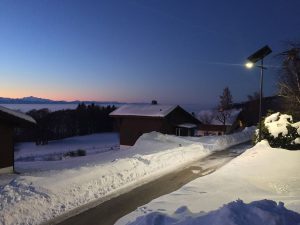
Solar Lighting That Works in Winter
How Fonroche Designs Solar Lighting That Works in Winter
Does solar lighting work in winter? Commercial solar lighting systems are working hard as winter approaches and, I’m sure plenty of off-the-shelf solar lighting products are struggling or not working at all. Though the concept of solar lighting simple, getting great lighting performance 365 nights a year isn’t. Here’s what Fonroche’s application engineers consider when they propose a solar lighting for a public project.
Plan for the Worst
Solar lights that work in winter are designed for the worst case conditions in mind. That’s why Fonroche creates a solar lighting application design for each project it sells. We complete a site specific energy analysis, a photometric design based on winter light output and define the system sizing to guarantee success.
Winter introduces several challenges, even in the sunniest parts of the country.
Night Length – In winter the duty cycle (number of hours that lighting is needed) increases by a lot. Even in Miami, the difference in night length between June and December is about 3 hours.
Less Solar Power – Since nights are longer, your solar lighting system has fewer daytime hours to collect energy. Not only that, the sun is hitting the panel at lower angle.
Weather – In many parts of the country, cloudy weather is typical for winter and, in the north, snow can cause problems for your solar lighting system in winter. Panels that don’t have enough tilt will collect snow instead of sloughing it off.
Freezing Temperatures – Older solar lighting systems used some form of lead acid battery such as AGM or Gel. These batteries have a good operating range but lose a lot of capacity in cold weather. That means you have less energy just when you need it most. Many Lithium Ion batteries operate well in cold temperatures but charging them in freezing temperatures starts a plating process that deteriorates them. You’ll need to change the batteries more frequently. Fonroche offers industrial Nickel Metal Hydride battery formulations that can operate -40°C (-40°F) to +70°C (158°F).
See for Yourself
These maps from the National Renewable Energy Laboratory illustrate the shift in available solar energy from summer to winter. Since it’s not practical to store energy from one season to another, solar lights that work in winter are designed with winter conditions in mind.

Choose Success Over Convenience
With so many low cost, off-the-shelf products available with little expense or effort, it’s tempting to just buy and try. For public lighting, that can be a big and costly mistake. The cost of maintenance and liability can quickly eliminate the benefits.
Fonroche provides solar lights that work in winter and all year round. You can expect your Smartlight system to last 20 years or more. And your first scheduled maintenance will be in 10 or more years.

